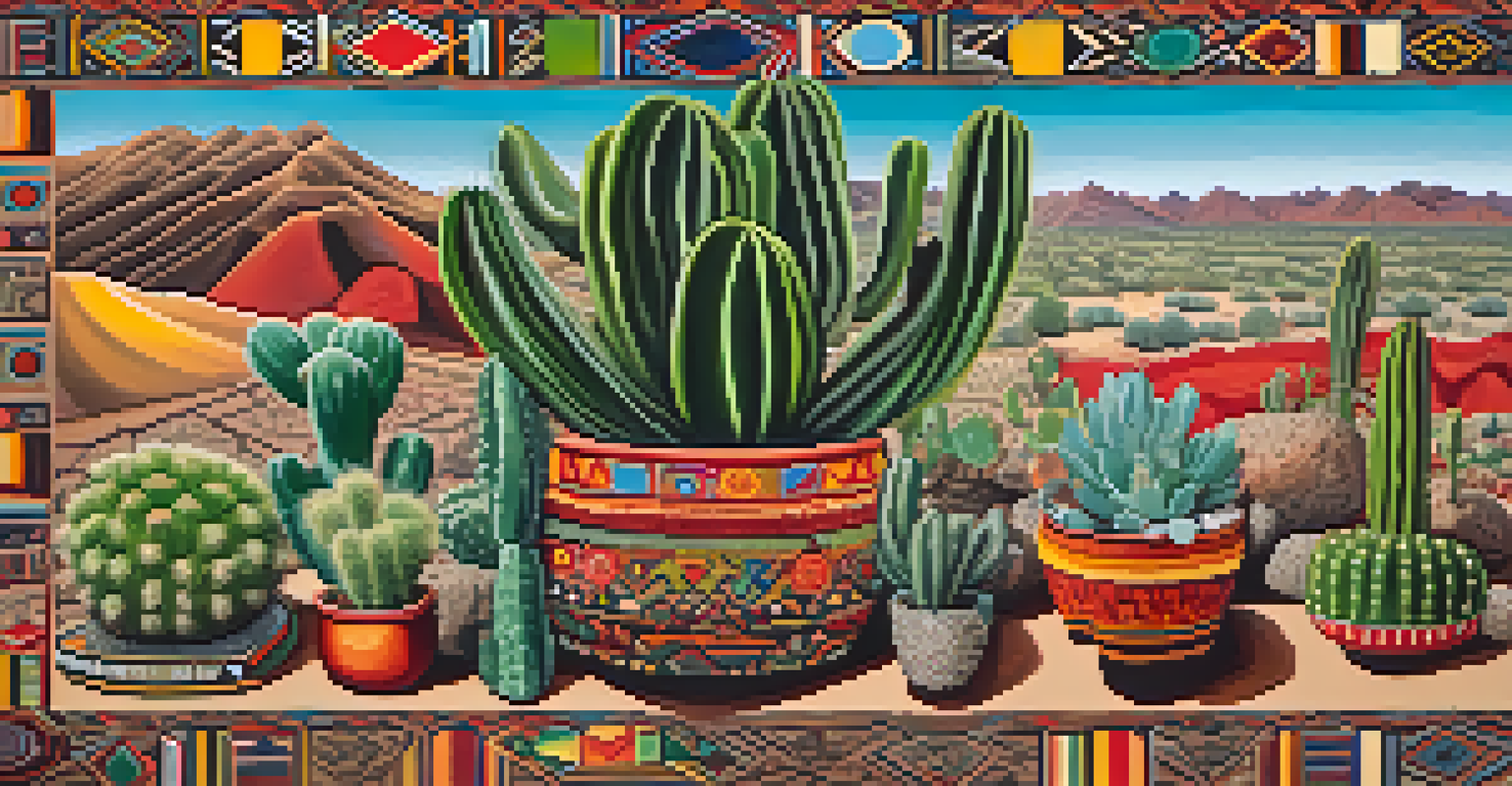Cultural Significance of Peyote in Indigenous Cohesion

Understanding Peyote: A Brief Overview
Peyote, a small cactus native to Mexico and the Southwestern United States, has been used for thousands of years by Indigenous peoples for its psychoactive properties. The active compound, mescaline, induces altered states of consciousness, which many believe facilitate spiritual insights and connections with the divine. This plant is not just a substance; it is a sacred icon in many cultures, symbolizing a deeper understanding of existence.
The use of peyote is a sacred and integral part of Indigenous spirituality, representing a connection to the past and a means of healing for the present.
Within Indigenous communities, peyote is often integral to religious ceremonies and rituals. It serves as a tool for healing, guidance, and communication with ancestors, reinforcing cultural identity and continuity. For many, the experience of consuming peyote is more than a personal journey—it's a communal rite that binds individuals together through shared beliefs and experiences.
The significance of peyote goes beyond its psychoactive effects; it embodies the values and traditions that shape Indigenous life. As a symbol of resistance against colonization and cultural erasure, peyote has become a powerful emblem of Indigenous sovereignty and identity.
Peyote in Rituals: A Communal Experience
In various Indigenous cultures, peyote ceremonies often involve communal gatherings where participants consume the cactus in a guided setting. These rituals are not merely about the individual experience but emphasize collective participation, fostering a sense of unity and support. Participants often share songs, prayers, and stories, reinforcing their cultural ties and shared histories.

The ceremonial use of peyote is deeply rooted in tradition, with specific practices passed down through generations. Elders often play a crucial role, guiding the younger members of the community through the experience, ensuring that the spiritual and cultural significance of the ritual is preserved. This mentorship helps to foster a sense of responsibility among younger generations to uphold Indigenous traditions.
Peyote as Cultural Icon
Peyote serves as a sacred symbol of identity and resilience for Indigenous peoples, embodying their traditions and spiritual practices.
Moreover, these rituals often serve as a safe space for discussing personal struggles and communal issues. By coming together in this sacred context, participants create a supportive environment that promotes healing, understanding, and resilience within the community.
Peyote and Identity: A Symbol of Resilience
For many Indigenous peoples, peyote is more than a plant; it represents a profound aspect of their identity. The use of peyote is often linked to cultural pride, as it embodies the survival of traditions in the face of historical oppression. This connection to peyote can help foster a sense of belonging and purpose within the community.
Peyote is not just a plant, but a symbol of resilience and identity for Indigenous peoples, embodying their struggles and triumphs throughout history.
Additionally, peyote serves as a unifying force among different Indigenous groups. Despite the diversity of languages and cultures, the shared practice of peyote consumption can bridge gaps and encourage solidarity among tribes. This collective identity is vital for the ongoing fight for Indigenous rights and recognition.
The resilience symbolized by peyote is particularly relevant today, as many Indigenous communities seek to reclaim their cultural practices and assert their rights. By embracing peyote as a sacred element of their heritage, these communities can challenge stereotypes and promote a deeper understanding of their cultures.
Modern Challenges: Peyote and Legal Issues
In contemporary society, the use of peyote faces various legal challenges, particularly in the United States. While the American Indian Religious Freedom Act protects the right of Indigenous peoples to use peyote in religious ceremonies, this legal framework is often insufficient. Many Indigenous groups continue to advocate for clearer protections and the right to access peyote without legal repercussions.
The increasing popularity of peyote among non-Indigenous individuals poses another challenge. As more people seek out peyote for its psychoactive effects, there is a risk of cultural appropriation and exploitation. Indigenous communities are increasingly vocal about the importance of respecting the sacred nature of peyote, urging outsiders to understand its significance within their cultural context.
Communal Healing Through Rituals
Indigenous peyote ceremonies emphasize collective participation, fostering unity and support while addressing personal and communal issues.
Balancing the preservation of traditional practices with modern legal frameworks is no easy feat. However, ongoing discussions and advocacy efforts are essential in ensuring that peyote remains a vital part of Indigenous identity and cohesion.
Peyote and Healing: A Path to Wellness
The healing properties of peyote are deeply acknowledged within many Indigenous cultures. Peyote ceremonies are often used as a means to address physical, emotional, and spiritual ailments. Participants frequently report profound experiences of healing and reconciliation during these rituals, reinforcing the idea that wellness is a holistic journey.
In these contexts, peyote acts as a facilitator for introspection and understanding. Many individuals find that the insights gained during these ceremonies allow them to confront personal struggles and traumas. This process not only promotes individual healing but also cultivates a stronger sense of community as members support one another through their journeys.
The emphasis on collective healing through peyote underscores the belief that personal well-being is interconnected with communal health. By engaging in these ceremonies, individuals contribute to the overall resilience and strength of their communities, fostering a shared commitment to wellness.
Education and Awareness: Bridging Generational Gaps
Education plays a crucial role in preserving the cultural significance of peyote among younger generations. Many Indigenous communities recognize the importance of teaching their youth about the history and spiritual practices associated with peyote. By fostering an understanding of its significance, they help ensure that these traditions continue to thrive.
Workshops and community gatherings often serve as platforms for sharing knowledge about peyote's role in Indigenous culture. These events not only educate younger community members but also invite broader audiences to engage with Indigenous cultures respectfully. This increased awareness can help combat stereotypes and foster greater appreciation for Indigenous practices.
Legal Challenges for Peyote Use
Contemporary legal issues pose significant challenges for the use of peyote in Indigenous ceremonies, highlighting the need for clearer protections.
Moreover, the integration of peyote education into broader discussions about Indigenous rights and sovereignty is essential. By highlighting the cultural significance of peyote, advocates can strengthen the case for legal protections and rights related to its use, creating a more supportive environment for Indigenous peoples.
The Future of Peyote: A Cultural Legacy
As we look to the future, the cultural legacy of peyote remains a vital part of Indigenous identity. The ongoing efforts to protect and preserve peyote practices reflect a broader commitment to safeguarding Indigenous traditions in an ever-changing world. This legacy is not just about the plant itself but about the values, stories, and histories it embodies.
The resurgence of interest in Indigenous practices, including the use of peyote, offers a unique opportunity for cultural revitalization. As more people recognize the importance of these traditions, there is potential for greater solidarity between Indigenous and non-Indigenous communities. This collaboration can lead to mutual respect and understanding, fostering a richer dialogue about culture and spirituality.

Ultimately, the future of peyote lies in the hands of Indigenous peoples themselves. By continuing to honor and practice their traditions, they ensure that the significance of peyote will not only endure but also evolve, serving as a beacon of resilience and cultural pride for generations to come.